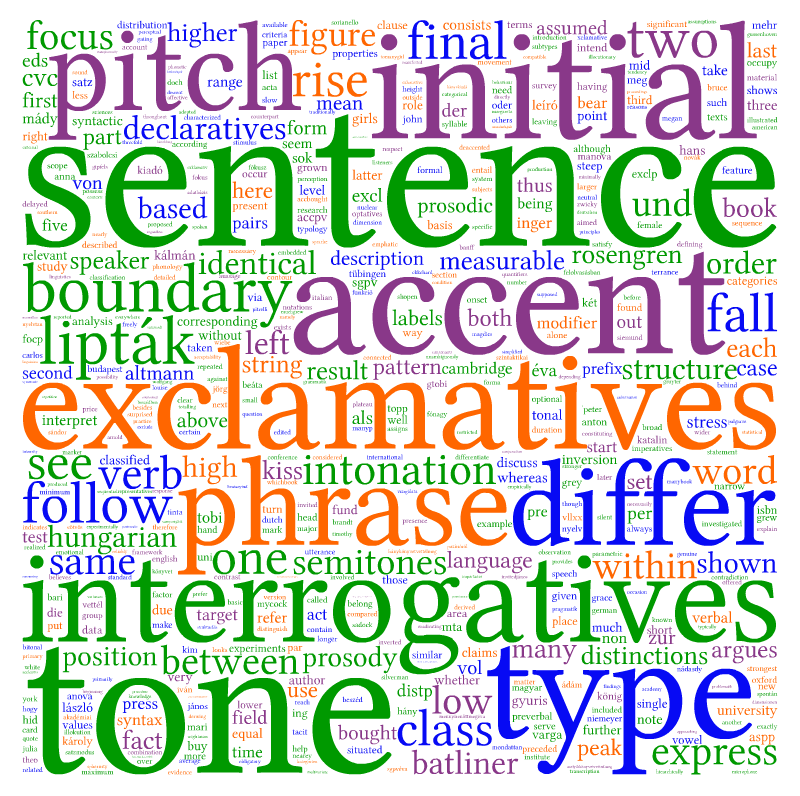
In theoretical classifications of clause or sentence types (e.g., Sadock & Zwicky 1985 and König & Siemund 2007), exclamatives are traditionally considered to be outside of the set of basic sentence types (constituted by declaratives, interrogatives and imperatives), and to belong to the set of minor sentence types (together with optatives, among others). The basis for this distinction is that whereas declaratives, interrogatives and imperatives are all definable with the help of a small number of necessary and sufficient formal criteria in the natural languages where they occur, there do not seem to be equally available unambiguous formal criteria for setting apart structures that express the meaning attributed to exclamatives. This meaning is described by König & Siemund as “an affective response to what is taken to be a fact,” namely, “convey[ing] the speaker's surprise that some present situation is remarkable” (2007: 316). These authors note that in most cases, the sentences expressing the structural meaning described above are syntactically identical to either declaratives or interrogatives in the same languages, and the only property they share among themselves is their intonation pattern.
Rosengren (1992, 1994), closely following Brandt et al. (1992: 78), argues strongly against intonation being a marker of clause or sentence types, primarily on the basis of the fact that it cannot be used to differentiate between embedded clause types. Rosengren believes instead that all exclamative sentences belong either to the declarative or the interrogative form types, their special interpretational feature being orthogonal to those features that distinguish between sentence types. This interpretational feature is the expression of a specific expressive illocutionary type, which is directly connected to “emphatic stress.”
In the framework proposed by Altmann (1993), prosodic properties are assumed to have a role parallel to syntactic and morphological ones in distinguishing between German sentence types, and thus exclamatives are treated on a par with declaratives and interrogatives. (Altmann (1993) does not discuss embedded clauses, therefore, the problem pointed out by Rosengren does not arise here.)
According to the traditional Hungarian view on sentence types (cf. Károly 1964), exclamatives are one of the five sentence types, having equal status with declaratives, interrogatives, imperatives and optatives. Károly claims that in order to be classified as an exclamative, a sentence has to satisfy the following four formal criteria: it must bear a so-called “emotional” intonation, and it may not possess the defining features of optatives, imperatives or interrogatives (1964: 79). Although he does not describe what the properties of the “emotional” intonation exactly are, he argues, on the one hand, that it is not restricted to exclamatives, but can also appear on optatives, imperatives and interrogatives, and, on the other hand, that there is no specific intonation pattern characterizing all exclamative sentences. These assumptions are compatible with the possibility that the “emotional” intonation patterns of structurally different subtypes of exclamatives are different in Hungarian.
The above claims seem to entail that the primary example given for the exclamative sentence type in Lipták (2006), shown in (1), cannot be classified as an exclamative in Károly’s framework, since this example is not only string-identical to a wh-interrogative sentence, shown in (2),☞For reasons of perspicuity, unless otherwise noted, Lipták’s (2006) examples are shown here without the optional sentence-initial conjunction hogy. but the two can also be assigned identical syntactic structures (as shown in Lipták 2006).☜In the glosses, pv denotes the verbal prefix, which belongs to the class of verbal modifiers, cf. É. Kiss 2002.
| Hány | könyvet | vettél | meg! |
| how.many | book-acc | bought-2sg | pv |
| Hány | könyvet | vettél | meg? |
| how.many | book-acc | bought-2sg | pv |
The wh-expressions in wh-interrogatives are standardly assumed to occupy the specifier of a Focus Phrase (focus position for short) within the hiearchically structured preverbal field of Hungarian, shown in (3). (Cf. É. Kiss 2002 for further discussion.) The verb moves to the head of the Focus Phrase, leaving the verbal modifier behind. Following common practice, in what follows, the verb-modifier order will be referred to as one involving inversion.
Lipták (2006) assumes that in sentences like (1) the wh-expression (or exclamative phrase, ExclP) also occupies the focus position. The structure she assigns to such sentences is repeated with inessential notational modifications in (4):
There exists, however, a well-formed variant of (1) with an identical interpretation, shown in (5), where the verbal prefix is situated in an immediately preverbal position. This sentence does not have a string-identical interrogative counterpart:
| Hány | könyvet | megvettél! |
| how many | book-acc | pv-bought-2sg |
Lipták (2006) argues that in examples like (5) the wh-expression is not in the focus position but is situated within the DistP field (referred to by DistP* in (3)), which consists of a range of distributive quantifiers, argued to be freely permutable by Szabolcsi (1997) and É. Kiss (2002). Kálmán (2001) observes, however, that emphatic sok ‘many’-expressions can only follow but cannot precede universal quantifiers within this field.☞The relevant section in Kálmán (2001) is authored by Attila Novák. The contrast is illustrated in (6)–(7):
| Mindenhova | ˈsok | lányt | meghívott | János. |
| everywhere.to | many | girl-acc | pv-invited | János |
| * ˈSok | lányt | mindenhova | meghívott | János. |
| many | girl-acc | everywhere.to | pv-invited | János |
Lipták (2006) proposes that whenever the wh-phrase is followed by the prefix-verb order in exclamative sentences it is situated in the last position of the DistP field, the same position that sok-phrases occupy in sentences like (6), referred to by her as manyP. The relevant structure is shown in (8).
Lipták considers both (1) and (5) as representatives of the exclamative sentence type.
As the acceptability of both (1) and (5) illustrate, in certain cases, inversion between the verb and the verbal modifier is optional. In a second group of cases, however, the corresponding wh-exclamatives and interrogatives are necessarily string-identical, either because there is no verbal modifier attached to the verb that could be in two places with respect to the verb, as in (9), or because the wh-expression is not compatible with the non-inverted order, as the contrast between (10) and (11) shows:
| Hova | bújtak | a | gyerekek! |
| where.to | hid-3pl | the | children |
| Melyik | könyvet | vetted | meg! |
| which | book-acc | bought-2sg | pv |
| *Melyik | könyvet | megvetted! |
| which | book-acc | pv-bought-2sg |
In a third group of cases, the exclamative can only occur with the non-inverted order, making it necessarily different from the corresponding interrogative:
| Mennyire | nőtt | meg | Éva? |
| how.much | grew-3sg | pv | Éva |
| *Mennyire | nőtt | meg | Éva! |
| how.much | grew-3sg | pv | Éva |
Lipták (2006) provides an exhaustive list of the wh-expressions that represent each of the above patterns, although she does not explain for all exclamative phrases what principles their category membership is to be derived from. Since we disagree with her concerning the acceptability of certain wh-expressions with the prefix-verb ordering, we prefer not to quote her classification here.☞For example, whereas Lipták (2006) assumes that ki ‘who’ can only occur in exclamatives in the focus position, we believe that it can be followed by the prefix-verb order, depending on the properties of the situation described. Detailed discussion of the points of disagreement will have to be left for another occasion, however.
Lipták argues that the two syntactic classes of exclamatives have an identical prosodic form, consisting of a “stress on the E[xclamative]-phrase and falling intonation following it” (2006: 345, fn. 3). Similar claims are made in Kálmán (2001: 137), where the prosody of wh-exclamatives is characterized as a “high tone followed by a slow descent.”
To our knowledge, no systematic investigation has been carried out on the prosody of Hungarian exclamatives so far. Curiously, they are missing from Fónagy & Magdics’s (1967) detailed survey as well. In sections 2–4 of this paper we present the first results of a study that aimed at the description of the prosody of one subclass of exclamatives, the so-called wh-exclamatives, based on experimentally-based data collection and analysis, which compared the prosodic properties of representatives of this sentence type to those of wh-interrogatives.☞See Lipták 2006 for the discussion of the syntax of further subtypes of the exclamative sentence type.
Wh-interrogatives in Hungarian, illustrated in (2) above, have a falling intonation contour. (Cf. Varga 2002 for further discussion.) According to É. Kiss (2002), the strongest accent within the Hungarian sentence falls on the left edge of the predicate part, that is, the part following the sentence-initial topic positions (Spec,TopP), which thus includes both the DistP field and the Focus Phrase. This entails that in interrogatives containing a single wh-expression, the latter bears the strongest accent (it cannot be preceded by distributive quantifiers, cf. Szabolcsi 1997 and É. Kiss 2002), and the following verb is deaccented (the accent on the focus is an eradicating one, see Kálmán & Nádasdy 1994).☞As noted by Varga (1982), there are cases where wh-expressions get deaccented as a result of being preceded by accented expressions having a focus interpretation, as in (i):
The question whether the above observation is relevant for the prosody of exclamatives would need further investigation.ˈPéter milyen nyelvet tanul? Péter what language-acc learns ‘What language does ˈPeter learn?’
According to Mycock (2010), who provides an intonational description of wh-interrogatives in Hungarian, the wh-word bears a falling pitch accent (H+L), which is identical to the pitch accent patterns found in preverbal foci (Mády 2012). Besides, Mycock claims that the wh-word in Hungarian interrogatives can optionally be preceded by a high tone (2010: 284).
Regarding wh-exclamatives, an empirically based description of their prosody is not available yet. Therefore, it is not known whether the wh-word is always accented and whether it is the only accented word within the sentence.
Before turning to our own experiments, we summarize the findings of some relevant studies on other languages.
Batliner (1988, 1989) follow Altmann (1987) in assuming that, at least in German, prosodic distinctions do not only differentiate between subtypes of major sentence types but they alone can serve to discriminate between two genuine sentence types, and that exclamatives constitute a sentence type of their own, though differing from some of the rest in terms of intonation only.
Thus, Batliner (1988) looks at the prosodic differences between verb-second sentences equally classifiable as declaratives and exclamatives in German, whereas Batliner (1989) investigates verb-initial sentences equally classifiable as yes-no interrogatives and exclamatives.
The perception experiments reported in Batliner (1988) indicate that a rise in the height of the f0-peak and the movement of the peak out of its neutral position results in a verb-second sentence being classified as an exclamative rather than as a declarative, although there seems to be no single prosodic factor that unambiguously marks a sentence of this type as an exclamative. Batliner (1989) found that in verb-initial sentences produced with an initial fall and a final rise, steep final rises exclude the exclamative interpretation (the steepness thus constituting the primary dimension). With less steep rises, the slope of the fall (constituting a secondary dimension) also plays a role: a steeper initial fall tends to trigger the sentence being classified as an exclamative.
Sorianello’s (2012) production and perception study compares the prosody of non-wh-exclamatives and declaratives having broad focus in Bari, a southern dialect of Italian. The production study targeting string-identical exclamatives and declaratives found high onset values for exclamatives (4 semitones higher than for the corresponding declaratives), followed by a fall only in the proximity of the last word, a raised baseline (about 3 semitones higher than that of the declaratives), and a larger pitch range (4 semitones larger than in declaratives). Exclamatives were faster at the beginning but slower at the end than their declarative counterparts, and had a greater mean intensity. The phonological descriptions offered by the author reflect these results in the following way. For exclamatives, a %H left boundary tone is postulated, and a high (H* or H*+L) nuclear pitch accent. Declaratives (with broad focus) are claimed to have a nuclear pitch accent realized by a bitonal falling tone, H+L* (or !H+L*). Since the final contour of both sentence types is falling, the phrase-final boundary tone is assumed to be low for both, L%.
In Sorianello’s (2012) perception experiment, subjects first heard short and then increasingly longer parts of the same sentences, and they had to decide each time whether the relevant parts were taken from a declarative or an exclamative. According to her results, exclamatives were better recognized on the basis of the initial string, which indicates the importance of the height of the initial f0 in distinguishing between the two sentence types.
Following the threefold classification of wh-exclamatives outlined above, which was based on the availability of the two possible preverbal positions for the wh-expression, we investigated three major classes of interrogative-exclamative pairs in our production experiments:
Each target sentence was presented in two contexts consisting of up to three sentences, to ensure that the target was correctly interpreted as a question (corresponding to an interrogative sentence) or an exclamation (corresponding to an exclamative sentence). All classes were represented by five interrogatives plus, in classes 1 and 2, one exclamative counterpart for each, and in class 3, two exclamative counterparts for each (with and without inversion), totalling in 45 stimulus sentences.
The texts including the target sentences were read by five subjects (3 females) between 20 and 45 years of age, in a silent environment, without repetition, in a sequential order. The material was recorded via a head-mounted microphone and an external sound card to a laptop.
Prosodic analysis was based on tonal categories and parametric measurements. Categories followed roughly those proposed in ToBI (Silverman et al. 1992), but they were phonetic rather than phonological notations of the pitch accent types. This means that a rising f0 within the accented syllable was labelled either L+H* or L*+H, the latter starting with a low plateau throughout the stressed vowel, and a falling f0 was labelled either H+L* or H*+L, again, the latter having a high plateau throughout the stressed vowel. H* and L* mark high and low accents without considerable movement within the accented syllable. Pitch accent labels are demonstrated in figure 1.
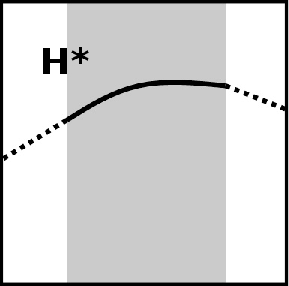
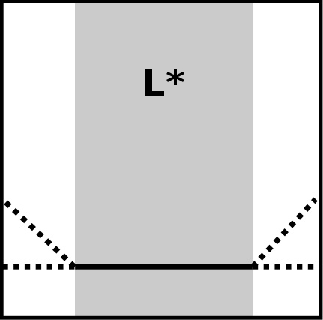
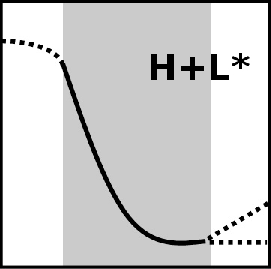
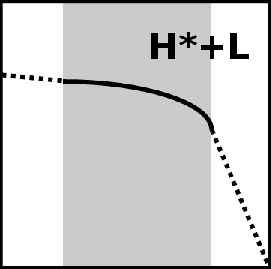

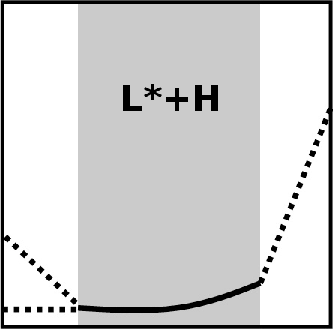
The following categories were used for labelling:
Since Hungarian has not been described in the framework of Intonational Phonology, there is no evidence for or against the presence of a mid (M) boundary tone in this language. We do not intend to argue for any of the alternatives at this point, but if the M tone should turn out to be relevant, distinctions based on it should not be overlooked in this analysis. The same is true for phrase-initial boundary tones: although the original ToBI system based on American English does not make use of them, they have been shown to be distinctive in other languages such as Dutch (Gussenhoven 2005).
Parametric measurements involved measurements of f0 and of durations:
F0 values were measured in semitones, CVC-durations were normalised to the duration of the entire sentence.
All target sentences were realized with a single pitch accent that was located on the wh-word. The category of pitch accents showed a different distribution in the two sentence types: interrogatives had either H* pitch accents or falling ones (H*+L or H+L*), whereas exclamatives nearly always had rising L+H* accents (see figure 2). The distinction was consistent for all classes, no matter whether the corresponding interrogative-exclamative pairs were string-identical or not.
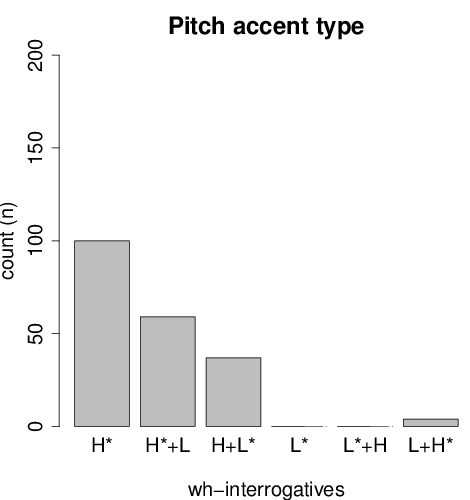
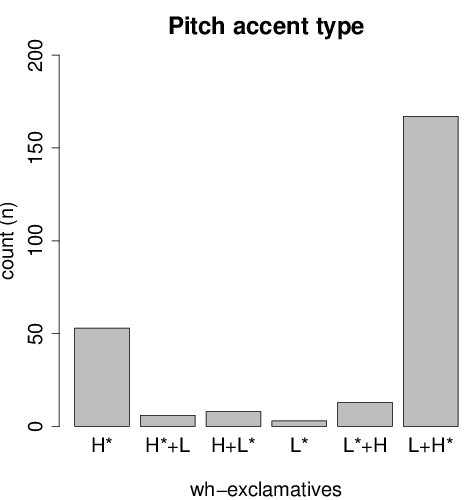
As for boundary tones, interrogatives were always characterised by a phrase-initial %H boundary tone, exclamatives by an %M or %L tone (see figure 3). Phrase-finally, interrogatives had H% boundary tones, exclamatives %M boundary tones (see figure 4).
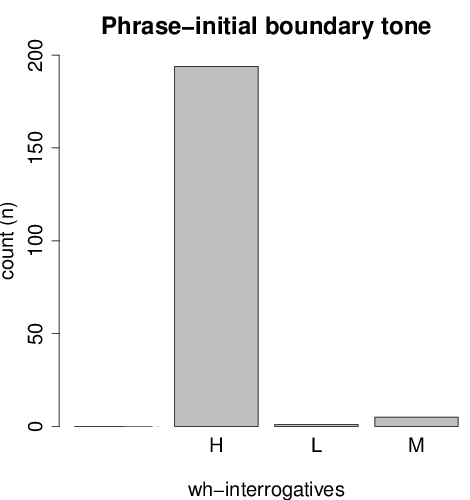
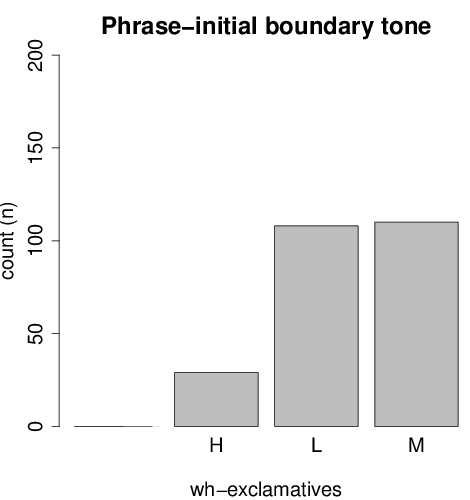
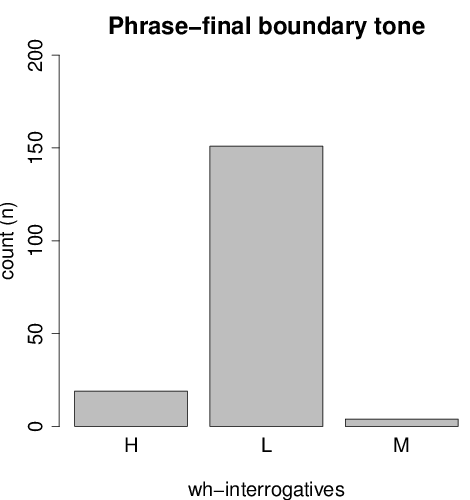
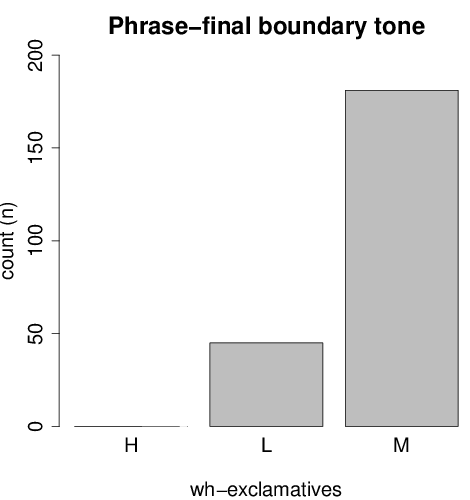
According to the categorical results, wh-interrogatives typically start with a high phrase-initial boundary tone followed by a high or a falling pitch accent and a low phrase-final boundary tone, whereas wh-exclamatives start with a mid or low initial boundary tone followed by a rising pitch accent and a mid final boundary tone. This is shown in figure 5.
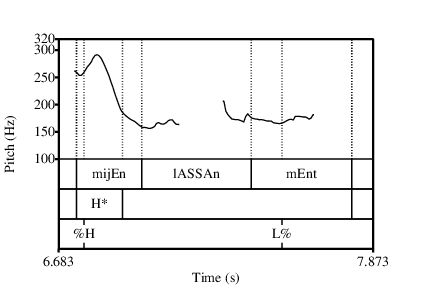
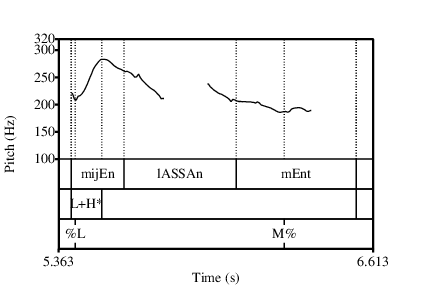
In the next section it will be tested whether different boundary tones are in fact manifested in measurable f0 differences sentence-initially and sentence-finally.
Statistical analysis was based on repeated-measures multivariate ANOVA (RM MANOVA) tests. This procedure has the advantage that within-speaker differences can be taken into account (similarly to RM ANOVA), and that sphericity (equality of variances between single factor levels) is not assumed, which is a necessary condition for RM ANOVA.
In our data, the f0 maximum of the pitch accent was more than 3 semitones higher in interrogatives than in exclamatives. This difference was significant for all classes of target sentences on the p < 0.05 level, although there was only a corresponding tendency for sentence pairs in class 1 (string-identical sentences, p = 0.059, see figure 6). Similarly, the f0 minimum in interrogatives was in average 2.75 semitones higher than in exclamatives, and this difference was significant for all classes (see figure 7). At the same time, pitch range did not differ significantly between the two sentence types in any of the three different classes. This is due to the variable behaviour between speakers: the two male speakers had wider pitch ranges for interrogatives, female speakers for exclamatives.
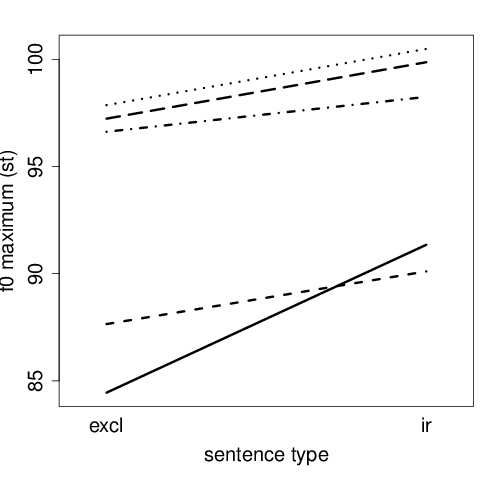
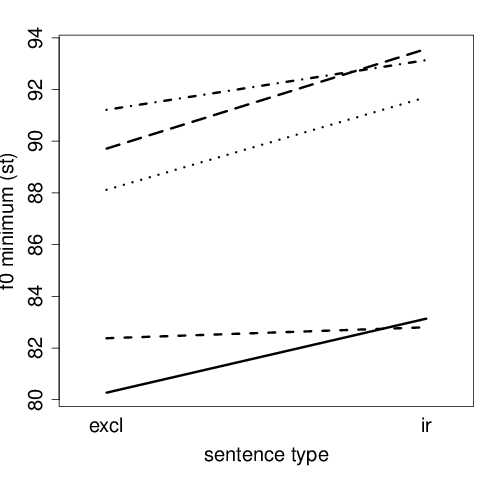
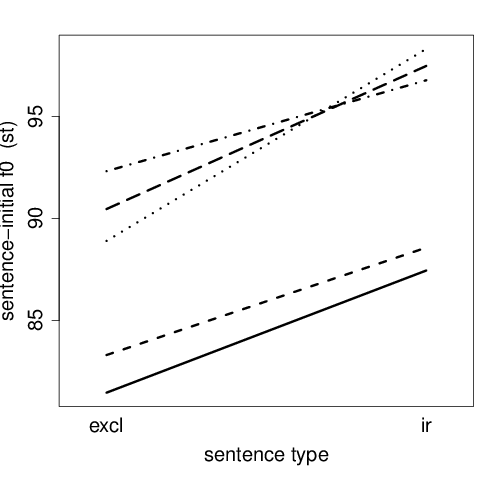
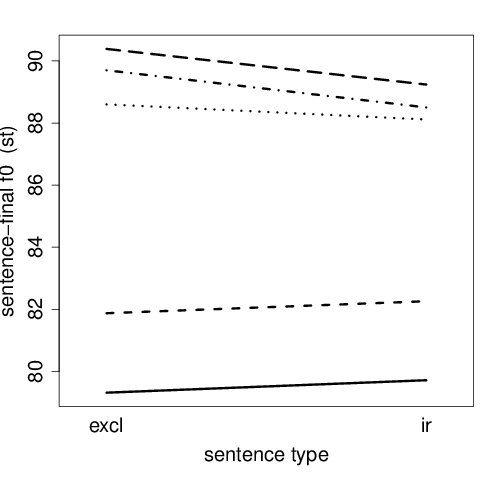
Sentence-initial f0 was in average 6 semitones higher in interrogatives than in exclamatives (significant difference in all three classes, see figure 8). At the same time, phrase-final f0 in interrogatives was only 0.24 semitones lower than in exclamatives, and the difference was not significant for any of the classes (see figure 8).
The distinction between wh-interrogatives and wh-exclamatives by means of intonation is very robust both on the categorical and the parametrical level. The tonal description of wh-interrogatives and wh-exclamatives can be given in the following simplified form:
The tonal description for wh-interrogatives based on this experiment is identical to the analysis given in Mycock (2010: 284). Interestingly, the tonal pattern of wh-exclamatives is very different: here the first part of the sentence was perceived lower than the second part. At the same time, the phrase-final tone was only perceptually higher in exclamatives than in interrogatives, not in absolute terms. This perceptual difference is probably due to the low start of the sentence: sentence-final f0 is relatively higher in exclamatives than in interrogatives, as compared to the respective sentence-initial f0 values.
Hungarian wh-interrogatives have an intonation pattern that is very similar to that of declaratives with narrow focus: they contain a falling pitch accent on the focus and a low phrase-final boundary tone. As opposed to this unmarked pattern, the intonation pattern of exclamatives consists of a low phrase-initial tone, followed by a rising accent and a M% final boundary tone. To put it metaphorically, it seems as if the “culmination” of the utterance was delayed within the utterance.
Delayed f0 peaks are in fact supposed to be equivalent to higher peaks. As it is argued in Gussenhoven, listeners have a tacit knowledge about the fact that a higher pitch will take longer to reach than a lower one, thus, they interpret later peaks as more emphatic (2004: 89ff). The fact that exclamatives included rising pitch accents in our material is in line with this statement. Either the rising pitch accent, i.e. an accent with a delayed peak, or the combination of the low initial boundary tone and the rising accent contribute to a stronger emphasis over the utterance as compared to interrogatives.
It is not clear at this point what the primarily distinctive cue between wh-interrogatives and wh-exclamatives is: the pitch accent type, the phrase-initial boundary tone or their combination. This issue will be investigated in further experiments.
Altmann, Hans. 1987. Zur Problematik der Konstitution von Satzmodi als Form-typen. In: Jörg Meibauer (ed.), Satzmodus zwischen Grammatik und Pragmatik. Tübingen: Niemeyer. 22–56.
Altmann, Hans. 1993. Satzmodus. In: Joachim Jacobs, Arnim von Stechow, Wolfgang Sternefeld, and Theo Vennemann (eds.), Syntax. Berlin: De Gruyter. 1006–1029.
Batliner, Anton. 1988. Der Exklamativ: mehr als Aussage oder doch nur mehr oder weniger Aussage? Experimente zur Rolle von Höhe und Position des F0-Gipfels. In Hans Altmann (ed.), Intonationsforschungen. Tübingen: Niemeyer. 243–271.
Batliner, Anton. 1989. Wieviel Halbtöne braucht die Frage? Merkmale, Dimensionen, Kategorien. In: Hans Altmann, Anton Batliner, and Wilhelm Oppenrieder (eds.), Zur Intonation von Modus und Fokus im Deutschen. Niemeyer: Tübingen. 111–162.
Brandt, Margareta, Marga Reis, Inger Rosengren, and Ilse Zimmerman. 1992. Satztyp, Satzmodus und Illokution. In: Inger Rosengren (ed.), Satz und Illokution, vol. 1. Tübingen: Niemeyer. 1–90.
É. Kiss, Katalin. 2002. The Syntax of Hungarian. Cambridge: Cambridge University Press.
Fónagy, Iván and Klára Magdics. 1967. A magyar beszéd dallama. Budapest: Akadémiai Kiadó.
Gussenhoven, Carlos. 2004. The phonology of tone and intonation. Cambridge: Cambridge University Press.
Gussenhoven, Carlos. 2005. Transcription of Dutch intonation. In: Sun-Ah Jun (ed.), Prosodic typology. Oxford: Oxford University Press. 118–145.
Kálmán, László. 2001. Magyar leíró nyelvtan 1. Mondattan. Budapest: Tinta Könyvkiadó.
Kálmán, László and Ádám Nádasdy. 1994. A hangsúly. In: Ferenc Kiefer (ed.), Strukturális magyar nyelvtan 2: Fonológia. Budapest: Akadémiai Kiadó. 393–467.
Károly, Sándor. 1964. A mondatfajták vizsgálata a funkció és a forma szempontjából. Nyelvtudományi Közlemények 66: 67–88.
König, Ekkehard and Peter Siemund. 2007. Speech act distinctions in syntax. In: Timothy Shopen (ed.), Language Typology and Syntactic Description, Vol. 1. Cambridge: Cambridge University Press. 276–324.
Lipták, Anikó. 2006. Word order in Hungarian exclamatives. Acta Linguistica Hungarica 53: 343–391.
Mády, Katalin. 2012. A fókusz prozódiai jelölése felolvasásban és spontán beszédben. In: Mária Gósy (ed.), Beszéd, adatbázis, kutatások. Budapest: Akadémiai Kiadó. 91–107.
Mycock, Louise. 2010. Prominence in Hungarian: the prosody–syntax connection. Transactions of the Philological Society 108/3: 265–297.
Rosengren, Inger. 1992. Zur Grammatik und Pragmatik der Exklamation. In: Inger Rosengren (ed.), Satz und Illokution, Band 1. Tübingen: Niemeyer. 263–306.
Rosengren, Inger. 1994. Expressive sentence types — a contradiction in terms. The case of exclamation. Sprache und Pragmatik 33: 38–68.
Sadock, Jerrold M. and Arnold M. Zwicky. 1985. Speech act distinctions in syntax. In: Timothy Shopen (ed.), Language Typology and Syntactic Description. Cambridge: Cambridge University Press. 155–196.
Silverman, Kim, Mary Beckman, John Pitrelli, Mari Ostendorf, Colin Wightman, Patti Price, Janet Pierrehumbert, and Julia Hirschberg. 1992. ToBI: a standard for labeling English prosody. In: John J. Ohala, Terrance N. Nearey, Bruce L. Derwing, Megan M. Hodge, and Grace E. Wiebe (eds.), Proceedings of the 2nd International Conference on Spoken Language Processing. Vol. 2. Banff, Alberta. 867–870.
Sorianello, Patrizia. 2012. A prosodic account of Italian exclamative sentences: a gating test. Paper presented at the Speech Prosody, 6th International Conference, Shanghai, 22–25 May 2012.
Szabolcsi, Anna. 1997. Strategies for Scope Taking. In: Anna Szabolcsi (ed.), Ways of Scope Taking. Amsterdam: Kluwer. 109–154.
Varga, László. 1982. Két szintaktikai pozícióról. Magyar Nyelv 78: 150–169.
Varga, László. 2002. Intonation and stress: evidence from Hungarian. Basingstoke & New York: Palgrave Macmillan.